Benefits Management Plan and Theory: WA Schools PPP Project Analysis
VerifiedAdded on 2022/11/28
|6
|1528
|90
Report
AI Summary
This report analyzes the WA Schools Public Private Partnership (PPP) Project, focusing on benefits management. It begins by defining benefits and outlining the five stages of benefits realization: identification, planning, execution, evaluation, and creating potentials for benefits. The report presents a table detailing these stages and related activities. It then explains the benefits management plan, emphasizing tangible (measurable) and intangible (less measurable) benefits. The plan includes key elements like benefit descriptions, schedules, ownership, measurement methods, and risk assessments. The report also addresses communication, quality, scope, and requirement management plans. References are provided to support the analysis. The student assignment aims to create a benefits management plan for the WA Schools PPP Project, treating it as a program and applying benefits management theory.
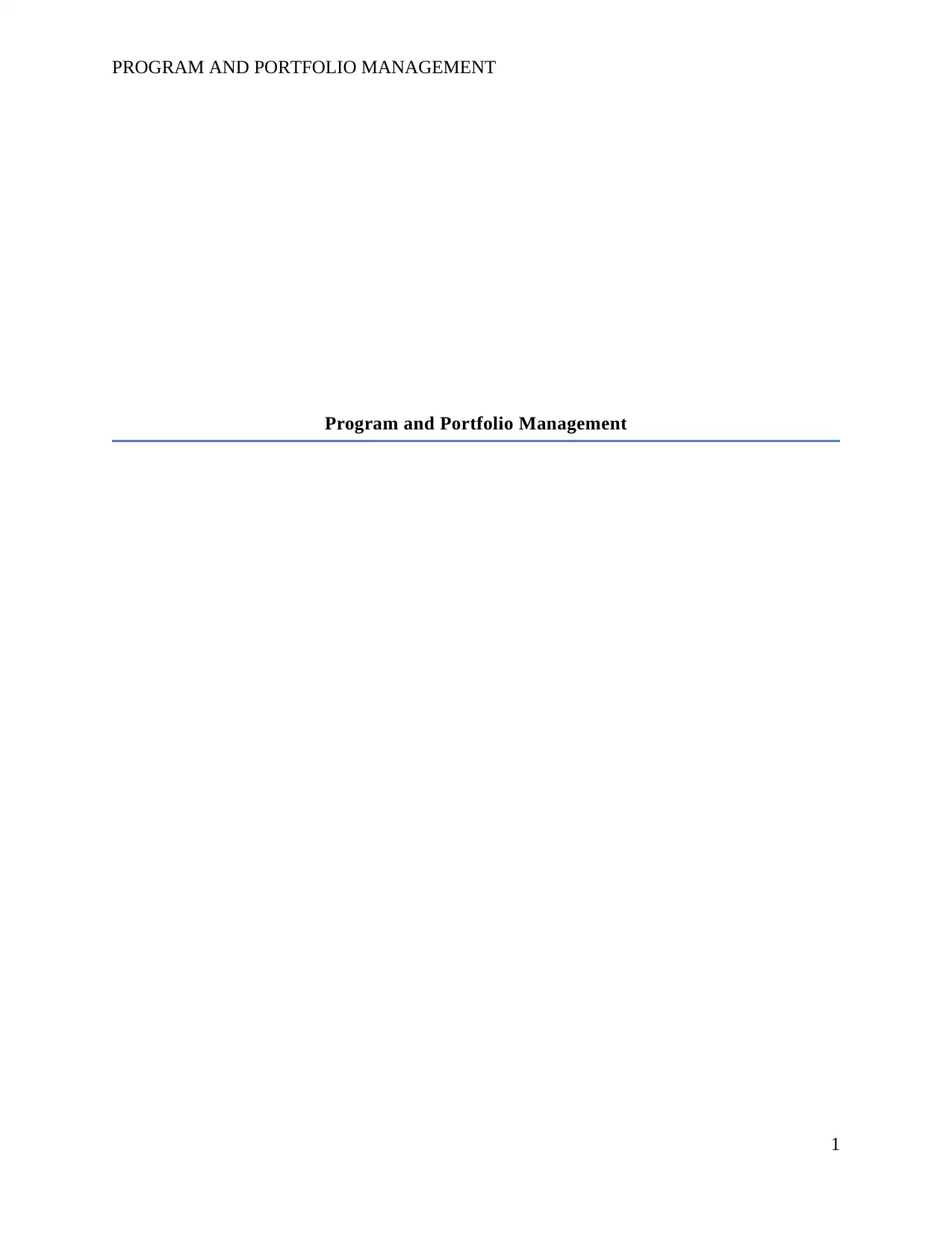
PROGRAM AND PORTFOLIO MANAGEMENT
Program and Portfolio Management
1
Program and Portfolio Management
1
Paraphrase This Document
Need a fresh take? Get an instant paraphrase of this document with our AI Paraphraser
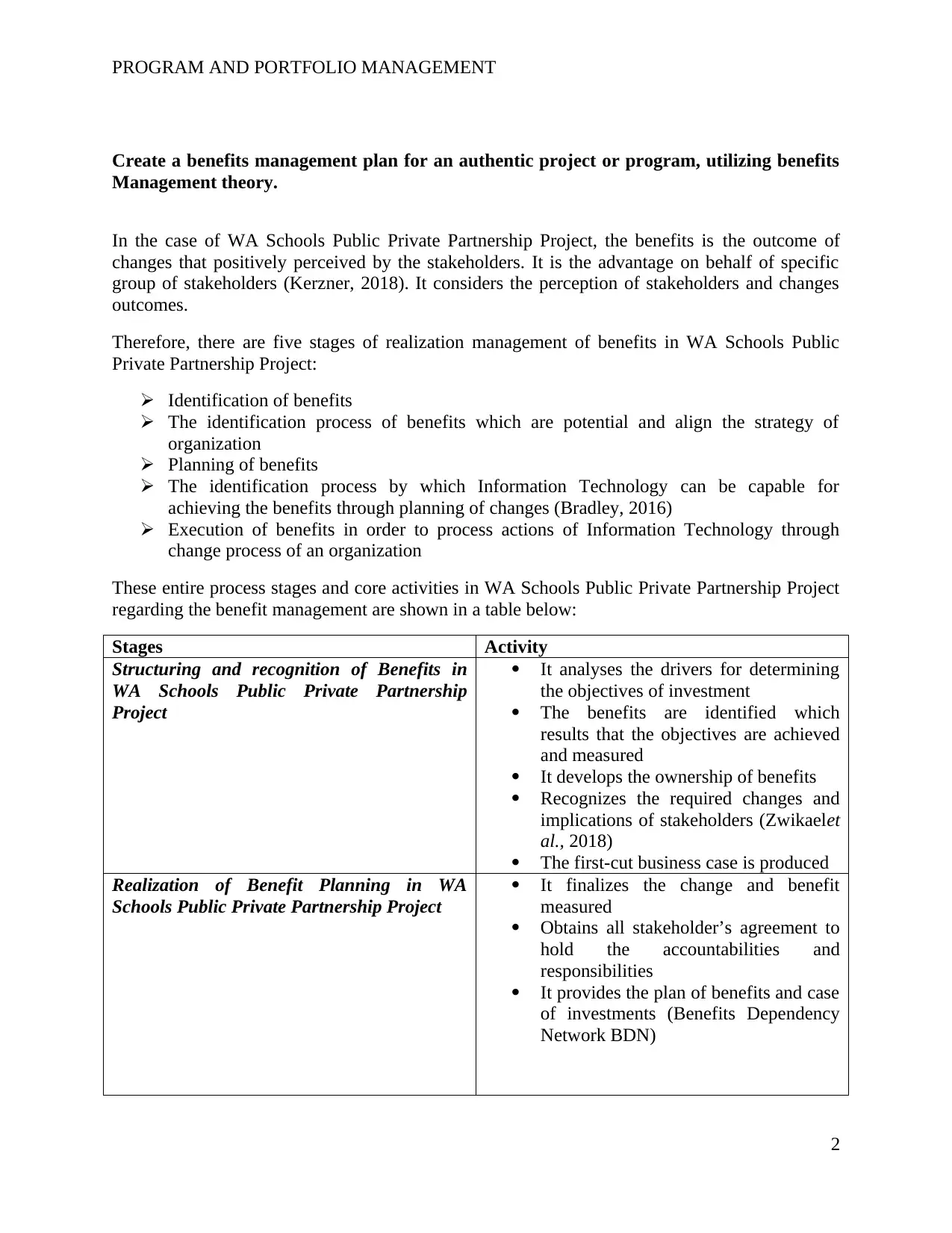
PROGRAM AND PORTFOLIO MANAGEMENT
Create a benefits management plan for an authentic project or program, utilizing benefits
Management theory.
In the case of WA Schools Public Private Partnership Project, the benefits is the outcome of
changes that positively perceived by the stakeholders. It is the advantage on behalf of specific
group of stakeholders (Kerzner, 2018). It considers the perception of stakeholders and changes
outcomes.
Therefore, there are five stages of realization management of benefits in WA Schools Public
Private Partnership Project:
Identification of benefits
The identification process of benefits which are potential and align the strategy of
organization
Planning of benefits
The identification process by which Information Technology can be capable for
achieving the benefits through planning of changes (Bradley, 2016)
Execution of benefits in order to process actions of Information Technology through
change process of an organization
These entire process stages and core activities in WA Schools Public Private Partnership Project
regarding the benefit management are shown in a table below:
Stages Activity
Structuring and recognition of Benefits in
WA Schools Public Private Partnership
Project
It analyses the drivers for determining
the objectives of investment
The benefits are identified which
results that the objectives are achieved
and measured
It develops the ownership of benefits
Recognizes the required changes and
implications of stakeholders (Zwikaelet
al., 2018)
The first-cut business case is produced
Realization of Benefit Planning in WA
Schools Public Private Partnership Project
It finalizes the change and benefit
measured
Obtains all stakeholder’s agreement to
hold the accountabilities and
responsibilities
It provides the plan of benefits and case
of investments (Benefits Dependency
Network BDN)
2
Create a benefits management plan for an authentic project or program, utilizing benefits
Management theory.
In the case of WA Schools Public Private Partnership Project, the benefits is the outcome of
changes that positively perceived by the stakeholders. It is the advantage on behalf of specific
group of stakeholders (Kerzner, 2018). It considers the perception of stakeholders and changes
outcomes.
Therefore, there are five stages of realization management of benefits in WA Schools Public
Private Partnership Project:
Identification of benefits
The identification process of benefits which are potential and align the strategy of
organization
Planning of benefits
The identification process by which Information Technology can be capable for
achieving the benefits through planning of changes (Bradley, 2016)
Execution of benefits in order to process actions of Information Technology through
change process of an organization
These entire process stages and core activities in WA Schools Public Private Partnership Project
regarding the benefit management are shown in a table below:
Stages Activity
Structuring and recognition of Benefits in
WA Schools Public Private Partnership
Project
It analyses the drivers for determining
the objectives of investment
The benefits are identified which
results that the objectives are achieved
and measured
It develops the ownership of benefits
Recognizes the required changes and
implications of stakeholders (Zwikaelet
al., 2018)
The first-cut business case is produced
Realization of Benefit Planning in WA
Schools Public Private Partnership Project
It finalizes the change and benefit
measured
Obtains all stakeholder’s agreement to
hold the accountabilities and
responsibilities
It provides the plan of benefits and case
of investments (Benefits Dependency
Network BDN)
2
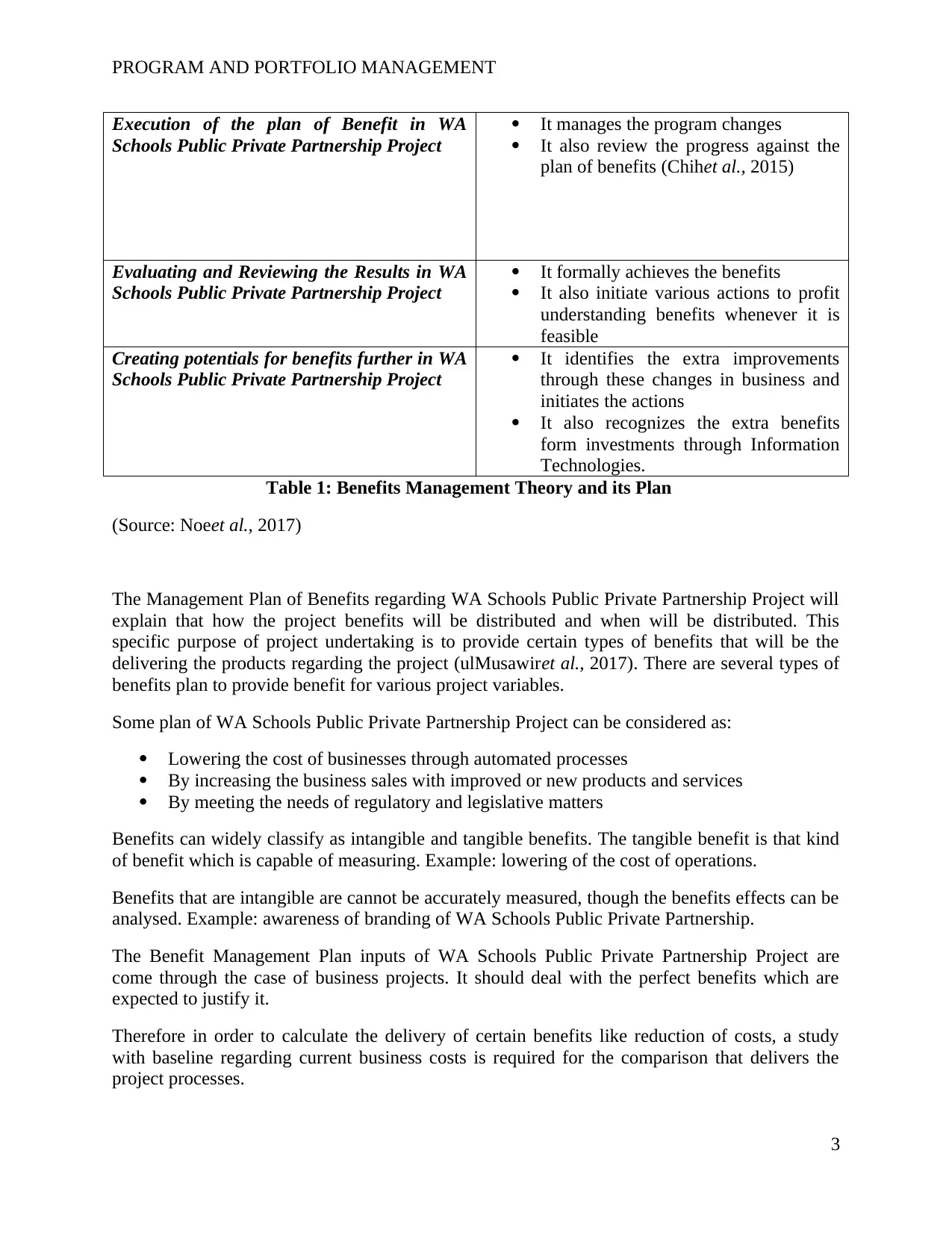
PROGRAM AND PORTFOLIO MANAGEMENT
Execution of the plan of Benefit in WA
Schools Public Private Partnership Project
It manages the program changes
It also review the progress against the
plan of benefits (Chihet al., 2015)
Evaluating and Reviewing the Results in WA
Schools Public Private Partnership Project
It formally achieves the benefits
It also initiate various actions to profit
understanding benefits whenever it is
feasible
Creating potentials for benefits further in WA
Schools Public Private Partnership Project
It identifies the extra improvements
through these changes in business and
initiates the actions
It also recognizes the extra benefits
form investments through Information
Technologies.
Table 1: Benefits Management Theory and its Plan
(Source: Noeet al., 2017)
The Management Plan of Benefits regarding WA Schools Public Private Partnership Project will
explain that how the project benefits will be distributed and when will be distributed. This
specific purpose of project undertaking is to provide certain types of benefits that will be the
delivering the products regarding the project (ulMusawiret al., 2017). There are several types of
benefits plan to provide benefit for various project variables.
Some plan of WA Schools Public Private Partnership Project can be considered as:
Lowering the cost of businesses through automated processes
By increasing the business sales with improved or new products and services
By meeting the needs of regulatory and legislative matters
Benefits can widely classify as intangible and tangible benefits. The tangible benefit is that kind
of benefit which is capable of measuring. Example: lowering of the cost of operations.
Benefits that are intangible are cannot be accurately measured, though the benefits effects can be
analysed. Example: awareness of branding of WA Schools Public Private Partnership.
The Benefit Management Plan inputs of WA Schools Public Private Partnership Project are
come through the case of business projects. It should deal with the perfect benefits which are
expected to justify it.
Therefore in order to calculate the delivery of certain benefits like reduction of costs, a study
with baseline regarding current business costs is required for the comparison that delivers the
project processes.
3
Execution of the plan of Benefit in WA
Schools Public Private Partnership Project
It manages the program changes
It also review the progress against the
plan of benefits (Chihet al., 2015)
Evaluating and Reviewing the Results in WA
Schools Public Private Partnership Project
It formally achieves the benefits
It also initiate various actions to profit
understanding benefits whenever it is
feasible
Creating potentials for benefits further in WA
Schools Public Private Partnership Project
It identifies the extra improvements
through these changes in business and
initiates the actions
It also recognizes the extra benefits
form investments through Information
Technologies.
Table 1: Benefits Management Theory and its Plan
(Source: Noeet al., 2017)
The Management Plan of Benefits regarding WA Schools Public Private Partnership Project will
explain that how the project benefits will be distributed and when will be distributed. This
specific purpose of project undertaking is to provide certain types of benefits that will be the
delivering the products regarding the project (ulMusawiret al., 2017). There are several types of
benefits plan to provide benefit for various project variables.
Some plan of WA Schools Public Private Partnership Project can be considered as:
Lowering the cost of businesses through automated processes
By increasing the business sales with improved or new products and services
By meeting the needs of regulatory and legislative matters
Benefits can widely classify as intangible and tangible benefits. The tangible benefit is that kind
of benefit which is capable of measuring. Example: lowering of the cost of operations.
Benefits that are intangible are cannot be accurately measured, though the benefits effects can be
analysed. Example: awareness of branding of WA Schools Public Private Partnership.
The Benefit Management Plan inputs of WA Schools Public Private Partnership Project are
come through the case of business projects. It should deal with the perfect benefits which are
expected to justify it.
Therefore in order to calculate the delivery of certain benefits like reduction of costs, a study
with baseline regarding current business costs is required for the comparison that delivers the
project processes.
3
⊘ This is a preview!⊘
Do you want full access?
Subscribe today to unlock all pages.

Trusted by 1+ million students worldwide
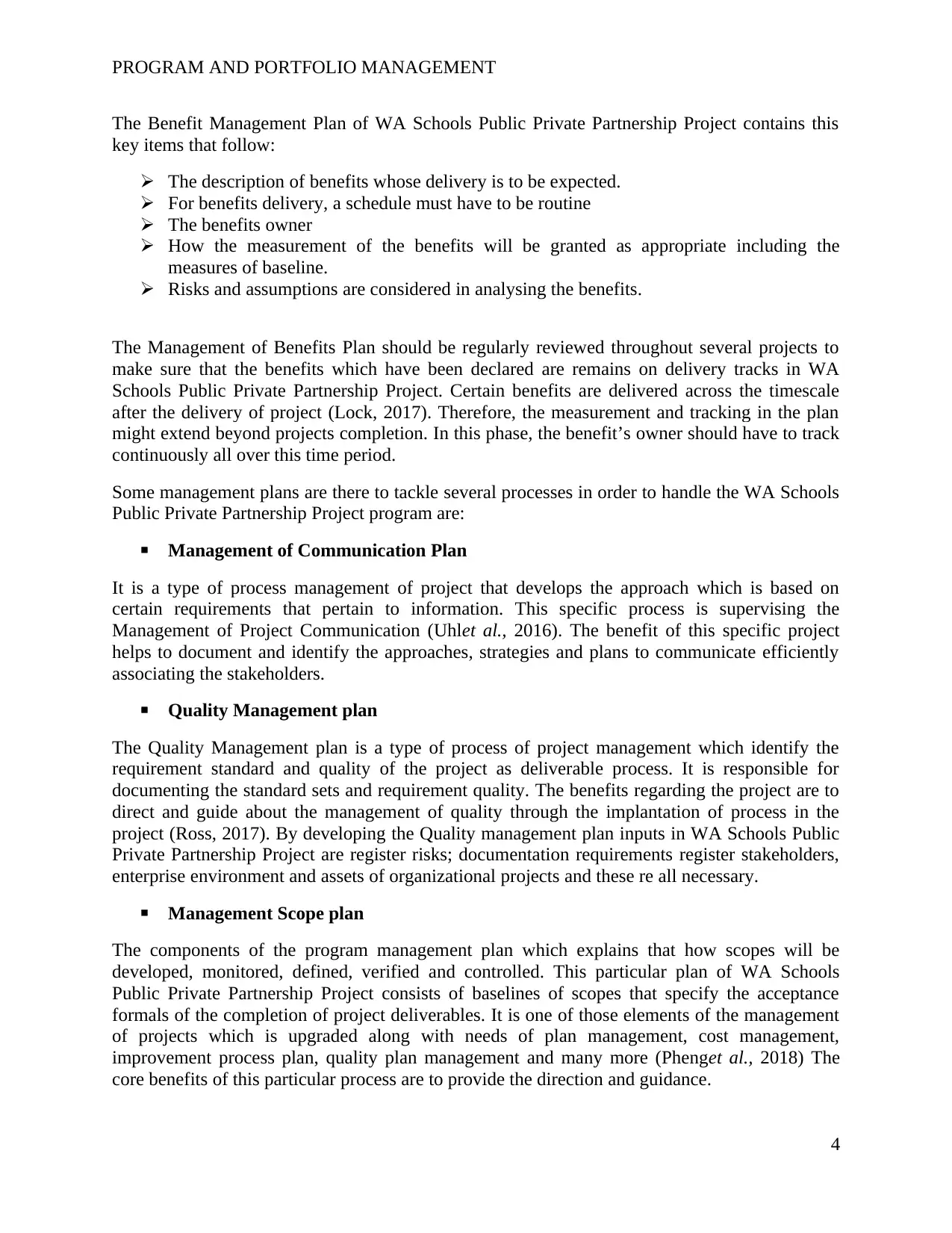
PROGRAM AND PORTFOLIO MANAGEMENT
The Benefit Management Plan of WA Schools Public Private Partnership Project contains this
key items that follow:
The description of benefits whose delivery is to be expected.
For benefits delivery, a schedule must have to be routine
The benefits owner
How the measurement of the benefits will be granted as appropriate including the
measures of baseline.
Risks and assumptions are considered in analysing the benefits.
The Management of Benefits Plan should be regularly reviewed throughout several projects to
make sure that the benefits which have been declared are remains on delivery tracks in WA
Schools Public Private Partnership Project. Certain benefits are delivered across the timescale
after the delivery of project (Lock, 2017). Therefore, the measurement and tracking in the plan
might extend beyond projects completion. In this phase, the benefit’s owner should have to track
continuously all over this time period.
Some management plans are there to tackle several processes in order to handle the WA Schools
Public Private Partnership Project program are:
Management of Communication Plan
It is a type of process management of project that develops the approach which is based on
certain requirements that pertain to information. This specific process is supervising the
Management of Project Communication (Uhlet al., 2016). The benefit of this specific project
helps to document and identify the approaches, strategies and plans to communicate efficiently
associating the stakeholders.
Quality Management plan
The Quality Management plan is a type of process of project management which identify the
requirement standard and quality of the project as deliverable process. It is responsible for
documenting the standard sets and requirement quality. The benefits regarding the project are to
direct and guide about the management of quality through the implantation of process in the
project (Ross, 2017). By developing the Quality management plan inputs in WA Schools Public
Private Partnership Project are register risks; documentation requirements register stakeholders,
enterprise environment and assets of organizational projects and these re all necessary.
Management Scope plan
The components of the program management plan which explains that how scopes will be
developed, monitored, defined, verified and controlled. This particular plan of WA Schools
Public Private Partnership Project consists of baselines of scopes that specify the acceptance
formals of the completion of project deliverables. It is one of those elements of the management
of projects which is upgraded along with needs of plan management, cost management,
improvement process plan, quality plan management and many more (Phenget al., 2018) The
core benefits of this particular process are to provide the direction and guidance.
4
The Benefit Management Plan of WA Schools Public Private Partnership Project contains this
key items that follow:
The description of benefits whose delivery is to be expected.
For benefits delivery, a schedule must have to be routine
The benefits owner
How the measurement of the benefits will be granted as appropriate including the
measures of baseline.
Risks and assumptions are considered in analysing the benefits.
The Management of Benefits Plan should be regularly reviewed throughout several projects to
make sure that the benefits which have been declared are remains on delivery tracks in WA
Schools Public Private Partnership Project. Certain benefits are delivered across the timescale
after the delivery of project (Lock, 2017). Therefore, the measurement and tracking in the plan
might extend beyond projects completion. In this phase, the benefit’s owner should have to track
continuously all over this time period.
Some management plans are there to tackle several processes in order to handle the WA Schools
Public Private Partnership Project program are:
Management of Communication Plan
It is a type of process management of project that develops the approach which is based on
certain requirements that pertain to information. This specific process is supervising the
Management of Project Communication (Uhlet al., 2016). The benefit of this specific project
helps to document and identify the approaches, strategies and plans to communicate efficiently
associating the stakeholders.
Quality Management plan
The Quality Management plan is a type of process of project management which identify the
requirement standard and quality of the project as deliverable process. It is responsible for
documenting the standard sets and requirement quality. The benefits regarding the project are to
direct and guide about the management of quality through the implantation of process in the
project (Ross, 2017). By developing the Quality management plan inputs in WA Schools Public
Private Partnership Project are register risks; documentation requirements register stakeholders,
enterprise environment and assets of organizational projects and these re all necessary.
Management Scope plan
The components of the program management plan which explains that how scopes will be
developed, monitored, defined, verified and controlled. This particular plan of WA Schools
Public Private Partnership Project consists of baselines of scopes that specify the acceptance
formals of the completion of project deliverables. It is one of those elements of the management
of projects which is upgraded along with needs of plan management, cost management,
improvement process plan, quality plan management and many more (Phenget al., 2018) The
core benefits of this particular process are to provide the direction and guidance.
4
Paraphrase This Document
Need a fresh take? Get an instant paraphrase of this document with our AI Paraphraser
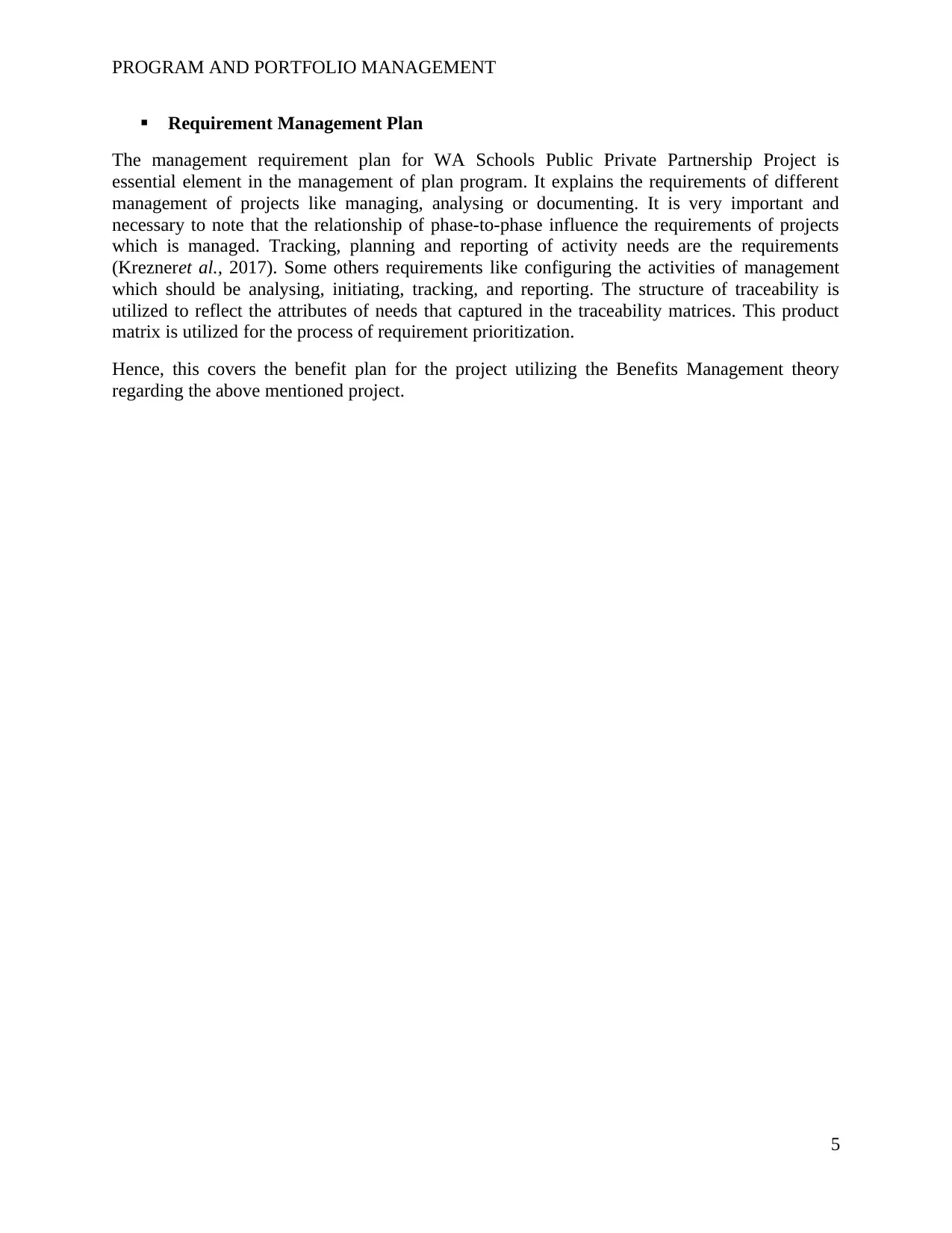
PROGRAM AND PORTFOLIO MANAGEMENT
Requirement Management Plan
The management requirement plan for WA Schools Public Private Partnership Project is
essential element in the management of plan program. It explains the requirements of different
management of projects like managing, analysing or documenting. It is very important and
necessary to note that the relationship of phase-to-phase influence the requirements of projects
which is managed. Tracking, planning and reporting of activity needs are the requirements
(Krezneret al., 2017). Some others requirements like configuring the activities of management
which should be analysing, initiating, tracking, and reporting. The structure of traceability is
utilized to reflect the attributes of needs that captured in the traceability matrices. This product
matrix is utilized for the process of requirement prioritization.
Hence, this covers the benefit plan for the project utilizing the Benefits Management theory
regarding the above mentioned project.
5
Requirement Management Plan
The management requirement plan for WA Schools Public Private Partnership Project is
essential element in the management of plan program. It explains the requirements of different
management of projects like managing, analysing or documenting. It is very important and
necessary to note that the relationship of phase-to-phase influence the requirements of projects
which is managed. Tracking, planning and reporting of activity needs are the requirements
(Krezneret al., 2017). Some others requirements like configuring the activities of management
which should be analysing, initiating, tracking, and reporting. The structure of traceability is
utilized to reflect the attributes of needs that captured in the traceability matrices. This product
matrix is utilized for the process of requirement prioritization.
Hence, this covers the benefit plan for the project utilizing the Benefits Management theory
regarding the above mentioned project.
5
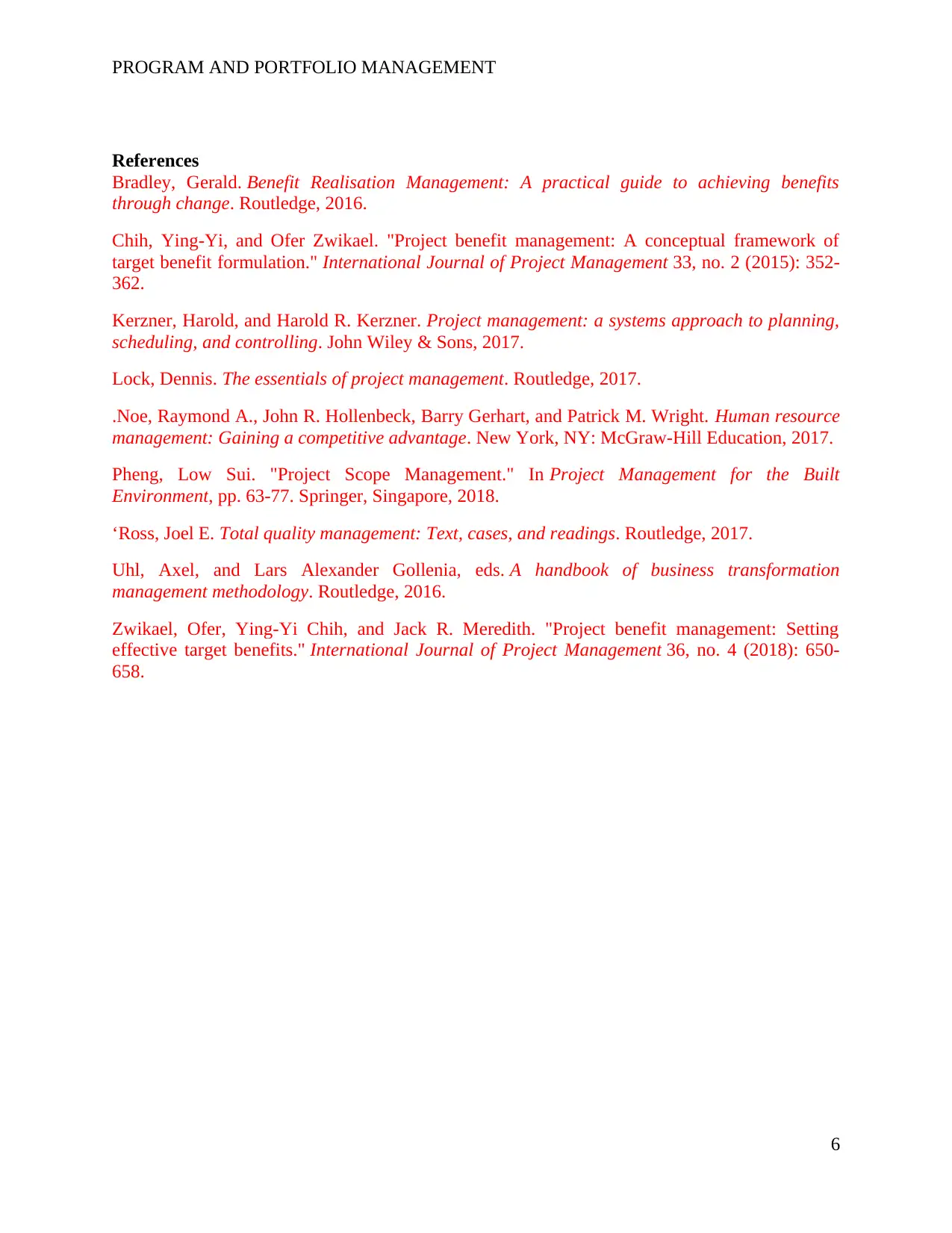
PROGRAM AND PORTFOLIO MANAGEMENT
References
Bradley, Gerald. Benefit Realisation Management: A practical guide to achieving benefits
through change. Routledge, 2016.
Chih, Ying-Yi, and Ofer Zwikael. "Project benefit management: A conceptual framework of
target benefit formulation." International Journal of Project Management 33, no. 2 (2015): 352-
362.
Kerzner, Harold, and Harold R. Kerzner. Project management: a systems approach to planning,
scheduling, and controlling. John Wiley & Sons, 2017.
Lock, Dennis. The essentials of project management. Routledge, 2017.
.Noe, Raymond A., John R. Hollenbeck, Barry Gerhart, and Patrick M. Wright. Human resource
management: Gaining a competitive advantage. New York, NY: McGraw-Hill Education, 2017.
Pheng, Low Sui. "Project Scope Management." In Project Management for the Built
Environment, pp. 63-77. Springer, Singapore, 2018.
‘Ross, Joel E. Total quality management: Text, cases, and readings. Routledge, 2017.
Uhl, Axel, and Lars Alexander Gollenia, eds. A handbook of business transformation
management methodology. Routledge, 2016.
Zwikael, Ofer, Ying-Yi Chih, and Jack R. Meredith. "Project benefit management: Setting
effective target benefits." International Journal of Project Management 36, no. 4 (2018): 650-
658.
6
References
Bradley, Gerald. Benefit Realisation Management: A practical guide to achieving benefits
through change. Routledge, 2016.
Chih, Ying-Yi, and Ofer Zwikael. "Project benefit management: A conceptual framework of
target benefit formulation." International Journal of Project Management 33, no. 2 (2015): 352-
362.
Kerzner, Harold, and Harold R. Kerzner. Project management: a systems approach to planning,
scheduling, and controlling. John Wiley & Sons, 2017.
Lock, Dennis. The essentials of project management. Routledge, 2017.
.Noe, Raymond A., John R. Hollenbeck, Barry Gerhart, and Patrick M. Wright. Human resource
management: Gaining a competitive advantage. New York, NY: McGraw-Hill Education, 2017.
Pheng, Low Sui. "Project Scope Management." In Project Management for the Built
Environment, pp. 63-77. Springer, Singapore, 2018.
‘Ross, Joel E. Total quality management: Text, cases, and readings. Routledge, 2017.
Uhl, Axel, and Lars Alexander Gollenia, eds. A handbook of business transformation
management methodology. Routledge, 2016.
Zwikael, Ofer, Ying-Yi Chih, and Jack R. Meredith. "Project benefit management: Setting
effective target benefits." International Journal of Project Management 36, no. 4 (2018): 650-
658.
6
⊘ This is a preview!⊘
Do you want full access?
Subscribe today to unlock all pages.

Trusted by 1+ million students worldwide
1 out of 6
Related Documents
Your All-in-One AI-Powered Toolkit for Academic Success.
+13062052269
info@desklib.com
Available 24*7 on WhatsApp / Email
![[object Object]](/_next/static/media/star-bottom.7253800d.svg)
Unlock your academic potential
Copyright © 2020–2025 A2Z Services. All Rights Reserved. Developed and managed by ZUCOL.





